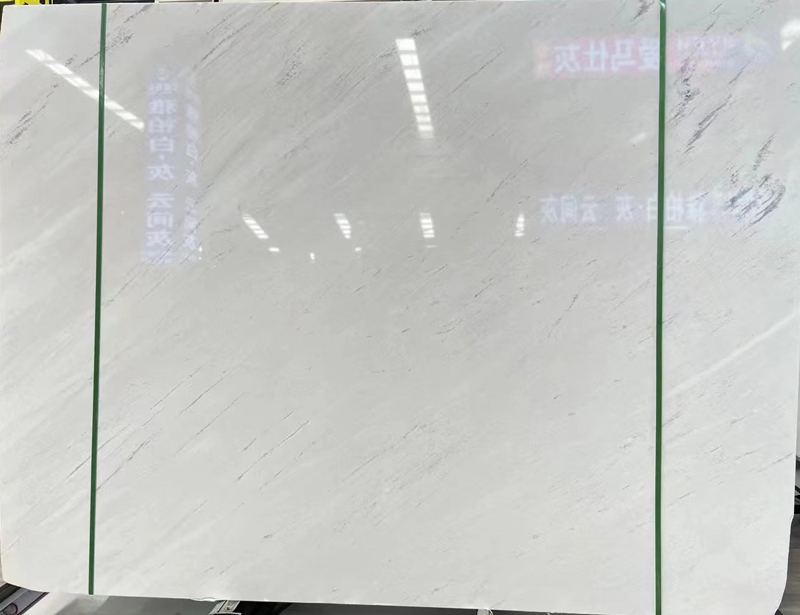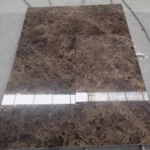White marble is the darling of all natural stones. It denotes something clean, with classic lines, and imposing quiet grace. Trends never mar its beauty; from ancient chisel works to today’s sleek décors, white marble still leads architecture and design projects globally. However, as worldwide supply chains broaden and quarry sources multiply, there has been an introduction to new variants of white marble—typically with minor distinctions that are not easy to pick at first sight.
It is not uncommon for designers and consumers to mix up two such variants-Fuji White Marble and Mármol blanco Polaris. They both have the elegant veining patterns typical of luxury stone over a clean white base, but they are, in fact, different materials. What sets them apart are geological origins, physical properties, and aesthetic details.
Is Polaris White Marble the same as Fuji White Marble? No, but their relationship is nuanced. Let’s take a look at their origins, characteristics, applications, and differences to see how each marble brings forth its own identity when used as part of architectural design.
The Global Appeal of White Marble
Before getting into any particular type, one should know why white marble still retains such a great place in the natural stone market. For centuries, white marble has been appreciated not just for its looks but also for its versatility and symbolic purity.
Carrara and Calacatta in Italy, Volakas in Greece, and Sivec in Macedonia: these are the sources of white marble found at the most iconic architectural landmarks across the globe. It is a material that can throw light around a room, with a silky surface to the touch and an opulent presence appropriate to settings of both classic and contemporary disposition.
Designers favor white marble for:
Countertops and kitchen islands
Bathroom walls and vanity tops
Flooring and wall cladding
Staircases and columns
Decorative sculptures and fireplaces
In recent years, as construction booms increase in Asian and Middle Eastern countries, white marble variants from different localities are highly demanded. These are marbles coming from quarries outside China and Vietnam. From this global leverage, several newer variants take their individual quarry sources up the aesthetic ladder with names such as Polaris White and Fuji White, among others.

What Is Polaris White Marble?
Polaris White Marble is a premium natural marble known for its cool white background and elegant, subtle veining. Named after the North Star (“Polaris”), this marble embodies clarity, brightness, and a serene aesthetic that appeals to modern minimalist architecture.
Origin and Source
Polaris White Marble usually comes from quarries in China, but because it looks so much like other white marbles from Vietnam or Southeast Asia, some suppliers list it that way. It has taken a place as one of the top choices when replacing European stones such as Carrara or Statuario, providing almost the same appearance at a much friendlier cost.
Appearance and Aesthetic Qualities
Polaris White features a pure to light-gray base tone, often with fine gray or silver linear veining that runs diagonally or softly across the surface. The veining is usually subtle rather than dramatic, giving it a clean and balanced appearance.
This understated veining makes Polaris White particularly popular for:
Contemporary interiors
High-end residential projects
Hotel lobbies and spa facilities
Modern kitchen and bath design
The surface finish of Polaris White can vary—from polished for high reflectivity to honed or matte for a more natural, soft-touch finish.
Physical Characteristics
Polaris White is medium-hard marble with a consistent grain and uniform background. It offers good workability for cutting and shaping, and it can achieve excellent edge detailing for countertops and wall panels.
It performs well in both dry and humid environments when properly sealed.
What Is Fuji White Marble?
Fuji White Marble reflects the cleanliness and peace of Mount Fuji- that snow-capped mountain which happens to be one of Japan’s icons. Yet, for all the suggestions of its name, this stone does not typically find quarrying within Japanese confines. The bulk of Fuji White Marble available in markets hails from China or sometimes Vietnam, as does Polaris White, though from distinct quarry beds carrying unique mineral compositions.
Appearance and Texture
Fuji White carries a creamy white shade with slight gray or beige undertones, showing a bit more warmth when put next to Polaris White. Most of its veins are softer, not straight at all, and sometimes look like clouds or misty, offering an appearance that is both gentle and rich.
It carries a subdued warmth that allows it to blend beautifully with interior palettes of wood, brass, or gold accents. Compare it against polaris white tones: see how much more inviting the warmer tone is.
Aplicaciones
Fuji White is often chosen for:
Bathroom and spa interiors
Hotel reception areas
Fireplace surroundings
Luxury residential flooring
It also performs well in large-format wall panels, where the uniform tone and delicate veining can create a seamless and calming aesthetic.
Key Differences Between Polaris White and Fuji White Marble
While both marbles belong to the family of light-toned stones and may look similar at first glance, several important distinctions set them apart.
1. Color Tone
Polaris White Marble tends toward a cooler, bluish-white base, with fine gray or silver veining.
Fuji White Marble has a warmer, cream-white base, often with beige or soft taupe undertones.
This difference in temperature affects how each marble interacts with lighting and surrounding materials.
2. Veining Pattern
Polaris White typically exhibits fine, linear, and subtle veins—ideal for modern minimalist designs.
Fuji White often displays softer, cloud-like veining, which feels more organic and fluid.
3. Reflectivity and Texture
Polished Polaris White reflects light more sharply, making spaces appear brighter. Fuji White, especially in honed finish, creates a more natural, soft ambiance.
4. Origin and Quarry Source
While both are primarily sourced in China, they originate from different quarry belts with distinct mineralogical compositions, leading to variations in density, color tone, and grain structure.
5. Price and Market Availability
Polaris White is generally slightly more affordable due to higher availability. Fuji White, with its unique tone and luxurious appeal, may command a premium price in some markets.

Geological and Material Composition
Marble is a metamorphic rock formed from limestone under heat and pressure. The differences between Polaris White and Fuji White arise from the variations in crystal grain size, trace minerals, and geological pressure during formation.
Polaris White Marble often shows a tighter crystalline structure with minimal impurities, contributing to its bright tone and fine veining.
Fuji White Marble contains slightly more calcite and dolomite variations, giving it a softer hue and occasionally a warmer feel.
Both stones are composed primarily of calcium carbonate (CaCO₃) but may include small traces of quartz, mica, or iron oxides that influence veining color and durability.
Durabilidad y mantenimiento
When it comes to practical performance, both marbles share similar characteristics but have nuances worth noting.
Scratch and Stain Resistance
Neither Polaris nor Fuji White is as hard as granite, but both are durable enough for most indoor applications. However, due to their light color, they can show stains more easily if unsealed.
Regular sealing and careful maintenance—such as using pH-neutral cleaners and avoiding acidic substances—help preserve their pristine appearance.
Moisture and Heat Resistance
Both marbles have moderate water absorption rates typical of natural marble. They are heat-resistant but should not be exposed directly to extreme thermal shock, such as placing hot pots directly on the surface.
Longevity
With proper care, both marbles can last decades. Over time, Polaris White may maintain a cooler tone, while Fuji White’s surface can develop a soft patina, enhancing its character.
Design Applications and Aesthetic Choices
Polaris White Marble: The Modern Minimalist Choice
Architects and designers often choose Polaris White for projects that demand visual clarity and modern simplicity. Its cool tone complements materials such as stainless steel, glass, and dark wood. It performs beautifully in:
Minimalist kitchens with high-contrast color palettes
Commercial lobbies where light reflection matters
Wall cladding in contemporary interiors
Fuji White Marble: The Warm Elegance
Fuji White, by contrast, exudes warmth and tranquility. It pairs well with brass, beige, and organic materials. Designers choose Fuji White when aiming for a spa-like, inviting, or natural ambiance:
Luxury bathrooms and spa centers
Residential floors with underfloor heating systems
Boutique hotels and hospitality interiors
Lighting Considerations
Lighting plays a crucial role in revealing the subtle differences between the two marbles. Polaris White gleams under cool LED lighting, emphasizing crispness and modernity. Fuji White glows under warm lighting, enhancing its inviting charm.
Environmental and Sustainability Factors
As sustainability becomes a main consideration in construction and design, both marbles have environmental advantages over synthetic materials. Natural stone, when quarried and processed responsibly, maintains a lower carbon footprint than ceramics or composites.
Abastecimiento de piedra suppliers who are responsible for the quarry and also ensure logistics efficiency so that waste is minimized. Both the Polaris and Fuji varieties can be reused or recycled in renovation projects, which adds to their sustainable appeal.
Pricing and Market Trends
In the global stone market, white marble pricing depends on several factors:
Quarry origin and extraction cost
Vein clarity and consistency
Block size and availability
Processing precision and polishing quality
Polaris White Marble is known as an economical premium white marble, whereas Fuji White bears a slightly higher price because of its warm tone and fine texture; however, the prices of both are far more pocket-friendly than Italian Statuario or Calacatta. This makes them perfect substitutes when used on a larger scale.
A rising preference for “bright and natural interiors” in most parts of Asia and the Middle East has pushed up the demand for both types. Architects and developers love their looks, performance, and cost.
Choosing Between Polaris and Fuji White Marble
The choice between Polaris and Fuji White Marble is largely a matter of aesthetic preference, put against the context of a specific project.
If your design concept requires cleanliness, minimal output, high brightness, and cool tones, then Polaris White Marble is exactly what you need. It represents flexibility, reflectiveness, and suits modern architecture perfectly.
Both are dependable and long-lasting. They offer versatility that gives enduring charm and beauty.
Care, Cleaning, and Long-Term Preservation
To maintain the beauty of either marble:
Seal surfaces regularly (every 6–12 months).
Wipe spills immediately, especially acidic liquids.
Use pH-neutral cleaners designed for natural stone.
Avoid abrasive pads or powders.
Periodic professional polishing can restore shine and remove micro-scratches, ensuring your marble remains stunning for decades.
So, is Polaris White Marble the same as Fuji White Marble?
While they may appear similar to the untrained eye, the answer is no.
Polaris White brings a cool, bright look with faint lines — great for sleek and bold spaces. Fuji White shows a warm, gentle feel with more natural shapes — best for calm, earthy styles. Both stand as top picks in the group of white stones, offering great looks, strength, and flexibility for many building uses.
In the end, it is about the feeling and look of warmth that a person wants to achieve in space. No matter which one between these two beautiful stones you pick, both will stand for the lasting grace and good name of natural marble — an old material that keeps on inspiring designers and homeowners all over the world.






